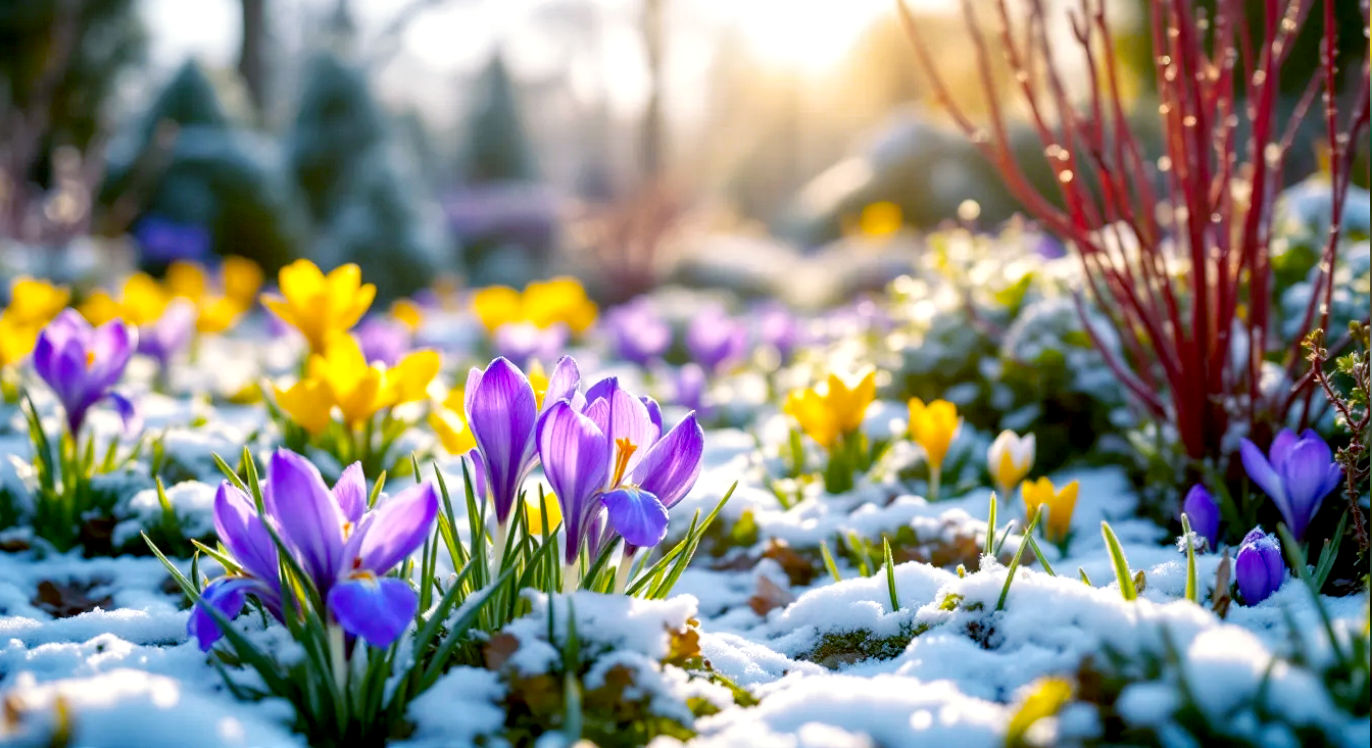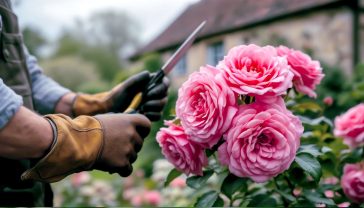A Splash of Colour All Year Round: The British Guide to a Garden That Never Sleeps
Discover how to create a vibrant British garden 365 days a year. This guide covers the best plants for spring, summer, autumn, and winter interest.

This post may contain affiliate links. If you make a purchase through these links, we may earn a commission at no additional cost to you.
Ever peek out your window on a dreary February morning and wish for a bit of cheer? A flash of yellow, a pop of pink, maybe a dash of purple? You’re not alone. We Brits are famous for our love of gardens, but many of us think of them as a summer-only affair. Once the roses fade and the dahlias droop, we resign ourselves to a world of brown and grey until spring rolls around again.
But it doesn’t have to be this way. What if I told you that with a little bit of clever planning, your garden could be a vibrant, colourful haven 365 days a year? Yes, even in the depths of a wet, windy January. It’s not magic, and you don’t need a sprawling estate or a team of gardeners to pull it off. It’s all about choosing the right plants for the right season.
This guide is your secret weapon to creating a garden that’s always got something interesting going on. We’ll walk you through the seasons, from the first snowdrops of spring to the festive berries of winter. We’ll look at superstar plants that shine when everything else is sleeping, and we’ll share simple tricks to keep your outdoor space looking lively, no matter what the British weather throws at it. So grab a cuppa, get comfortable, and let’s plan a garden that brings you joy all year round.
Getting the Basics Right: Your Garden’s Foundation
Before we start dreaming of winter-flowering cherry trees and flame-coloured dogwoods, we need to talk about the boring-but-important stuff. Getting the foundations right is like building a house – you wouldn’t start with the roof, would you? A little bit of prep work now will save you a lot of head-scratching later and give your plants the best possible start in life.
Know Your Patch: Soil and Sunlight
Think of your garden as a unique little world. The conditions in your backyard won’t be exactly the same as your neighbour’s, let alone someone living on the other side of the country. The two biggest things you need to understand are your soil and how much sun your garden gets.
What’s Your Soil Type?
British soil is a mixed bag. You might have heavy clay that gets waterlogged in winter, sandy soil that drains in a flash, or something in between.
- Clay Soil: This is common across much of the UK. It’s rich in nutrients but can be a pain to work with. It feels sticky when wet and bakes hard in summer. The good news is, once you improve it, it holds water well.
- Sandy Soil: This soil is light and easy to dig. It warms up quickly in spring, but it doesn’t hold onto water or nutrients very well, so you’ll need to feed and water your plants more often.
- Loam: This is the gardener’s dream! It’s a perfect mix of clay, sand, and organic matter. It’s easy to work with, holds moisture, and is full of nutrients.
- Chalky Soil: Often found over chalk or limestone bedrock, like the South Downs. It’s usually shallow, stony, and drains very quickly. It’s also alkaline, which means some plants, like rhododendrons, won’t be happy here.
How to Tell What You’ve Got: The simplest way is the ‘squeeze test’. Grab a handful of moist (not soaking wet) soil. If it rolls into a smooth, shiny sausage, you’ve got clay. If it feels gritty and falls apart, it’s sandy. If it forms a soft ball that crumbles easily, you’ve hit the jackpot – it’s loam.
Why Does It Matter? Some plants are fussier than others. A lavender plant will love free-draining sandy soil but will hate sitting in wet clay. Knowing your soil helps you choose plants that will thrive, not just survive. You can always improve your soil by digging in lots of organic matter, like well-rotted manure or garden compost. This breaks up heavy clay and helps sandy soil hold onto water.
The Sun Factor
Next, spend a day watching where the sun falls in your garden. Make a simple map. Where’s the sun in the morning? Where is it at midday? Which parts are shady all day long?
- Full Sun: Gets at least six hours of direct sun a day.
- Partial Shade: Gets between three and six hours of sun.
- Full Shade: Gets less than three hours of direct sun.
Remember that the sun’s path changes with the seasons. A spot that’s sunny in June might be in shade for most of the winter. Again, this helps you pick the right plants. Sun-loving Mediterranean herbs won’t be happy in a gloomy corner, while delicate ferns will get scorched in a south-facing border.
The Power of Green: Evergreen Structure
When we’re chasing colour, it’s easy to forget about the backbone of the garden: evergreen structure. These are the plants that keep their leaves all year round. They are the unsung heroes of the winter garden, providing shape, texture, and a permanent green backdrop when everything else has died back.
Think of them as the walls and furniture of your outdoor room. Without them, your garden can look empty and bare in winter. With them, you have a framework that your seasonal flowers and plants can pop against.
What to Use for Structure:
- Shrubs: Plants like Box (Buxus sempervirens), Yew (Taxus baccata), and Holly (Ilex aquifolium) are brilliant. You can clip them into neat shapes like balls or hedges to create formal lines, or let them grow more naturally.
- Grasses: Many ornamental grasses look fantastic in winter. The wispy flowerheads of Stipa gigantea catch the frost beautifully, while evergreen sedges like Carex ‘Evergold’ provide a splash of golden-green at ground level.
- Perennials: Some non-woody plants are evergreen too. Hellebores (we’ll talk more about these later!) have lovely, tough leaves. Bergenia, also known as elephant’s ears, has big, glossy leaves that often turn a lovely reddish-purple in the cold.
Placing these structural plants thoughtfully is key. Use them to mark the corners of a flower bed, frame a view, or create a sense of journey through the garden. Once this evergreen framework is in place, you can start painting with seasonal colour.
Spring: The Great Awakening
Ah, spring! After a long winter, there’s nothing quite like seeing the first signs of life. The days get longer, the birds start singing, and the garden slowly wakes up. This is a season of fresh, hopeful colour – think yellows, whites, blues, and soft pinks.
Early Spring: The First Heralds
Even when there’s still a chill in the air, some brave little plants are ready to get the show on the road. These early bloomers are small but mighty, bringing a massive dose of cheer when you need it most.
The Magic of Bulbs
Spring-flowering bulbs are a must-have for any garden. You plant them in the autumn, forget about them, and then they surprise you with a burst of colour from February onwards.
- Snowdrops (Galanthus nivalis): The absolute classic. A carpet of these delicate white flowers nodding in the breeze is a sure sign that winter’s grip is loosening. They look wonderful planted in big drifts under trees.
- Crocuses: From the bright yellow ‘Golden Yellow’ to the deep purple ‘Flower Record’, crocuses bring a splash of jewel-like colour to lawns and pots. They’re also a vital early food source for brave bees.
- Dwarf Irises (Iris reticulata): These little gems are simply stunning. They have intensely coloured flowers, often in shades of deep blue and purple with flashes of yellow. They’re perfect for a sunny spot at the front of a border or in a pot near the back door where you can admire them up close.
Beyond the Bulbs
It’s not just bulbs that shine in early spring. Some shrubs and perennials are eager to join the party too.
- Witch Hazel (Hamamelis): This is a real showstopper. In the depths of winter and into early spring, its bare branches are covered in spidery, fragrant flowers in shades of yellow, orange, or red. The scent on a crisp day is incredible.
- Hellebores (Helleborus x hybridus): Also known as the Christmas or Lenten Rose. These are absolute troopers. Their beautiful, bowl-shaped flowers, in shades of white, green, pink, and deep purple, hang their heads elegantly and last for months. They love a shady spot and will slowly spread to form lovely clumps.
- Winter Aconite (Eranthis hyemalis): These create a carpet of sunshine with their bright yellow, buttercup-like flowers surrounded by a ruff of green leaves. They pair brilliantly with snowdrops.
Mid- to Late Spring: The Volume Turns Up
As we move into April and May, the garden really hits its stride. The pace of growth is incredible, and the colours become bolder and more varied. This is the season of tulips, daffodils, and blossoming trees.
A Riot of Tulips and Daffs
- Daffodils (Narcissus): From the classic bright yellow trumpet daffs to delicate, multi-headed varieties and fragrant, white-and-orange ones, there’s a daffodil for everyone. Plant them in clumps in borders or drifts in lawns for a natural look.
- Tulips: Tulips offer an amazing range of colours and shapes. You can go for elegant, lily-flowered types, frilly parrot tulips, or classic, cup-shaped ones. They are fantastic in pots, allowing you to create stunning, concentrated displays of colour. Try planting them in layers in a pot – a technique called a ‘bulb lasagne’ – with later-flowering bulbs at the bottom and earlier ones on top for a continuous display.
Blossom and Blooms
This is the time for flowering shrubs and trees to steal the show. A small tree can have a huge impact in any garden.
- Magnolia: The sight of a magnolia tree in full bloom, its bare branches covered in huge, goblet-shaped flowers, is breathtaking. Magnolia stellata is a lovely, compact, star-flowered variety that’s great for smaller gardens.
- Flowering Cherry (Prunus): The quintessential spring blossom. There are dozens of varieties, from the pale pink clouds of ‘Kanzan’ to the delicate white flowers of the weeping ‘Kiku-shidare-zakura’.
- Forget-me-nots (Myosotis sylvatica): These create a beautiful haze of sky-blue at ground level, providing a perfect backdrop for taller tulips and wallflowers. They self-seed freely, so you’ll always have them popping up.
- Pulmonaria (Lungwort): A fantastic plant for shade, with pretty spotted leaves and clusters of flowers that often change colour from pink to blue as they age. It’s also a big favourite with early-emerging bees.
Summer: The Season of Plenty
Summer is when the garden is at its most lush and extravagant. The borders are full to bursting, the colours are bold and bright, and the air is filled with the buzz of insects and the scent of flowers. This is the time for roses, lavender, and a parade of colourful perennials.
Early Summer: The Overture
June is a magical month. The fresh greens of spring are still around, but the flower power is really starting to build. This is the season of classic cottage garden plants.
Cottage Garden Favourites
- Roses: A British garden isn’t complete without a rose. Whether you choose a climbing rose to scramble up a wall, a shrub rose for the middle of a border, or a compact patio rose for a pot, their beauty and fragrance are unmatched. For a classic look, try an old-fashioned English rose from David Austin, like the soft pink ‘Gertrude Jekyll’.
- Hardy Geraniums (Cranesbill): Not to be confused with the bright red bedding ‘geraniums’ (which are actually pelargoniums), hardy geraniums are brilliant border fillers. They come in shades of blue, pink, purple, and white and will flower their socks off for months. Geranium ‘Rozanne’ is a superstar, producing a sea of violet-blue flowers from June until the first frosts.
- Alliums: These ‘ornamental onions’ add a touch of drama and structure. Their huge, spherical flowerheads, usually in shades of purple, stand on tall, straight stems like lollipops. Allium ‘Purple Sensation’ is a popular and reliable choice. Even after the colour fades, the seed heads look fantastic well into winter.
- Foxgloves (Digitalis purpurea): Tall, stately spires of bell-shaped flowers add height and elegance to a shady corner. They are biennials, meaning they grow leaves one year and flower the next, but they self-seed so you’ll always have a new generation coming through.
Mid- to Late Summer: The Crescendo
As the heat builds in July and August, the colours shift. The soft pastels of early summer make way for hot, fiery oranges, vibrant reds, and deep, sultry purples.
Hot Colours and Prairie Plants
This is the time for plants that love the sun and can handle drier conditions. Many of these come from the great prairies of North America and look fantastic planted in big, bold drifts.
- Rudbeckia (Black-eyed Susan): These bring a splash of pure sunshine with their golden-yellow, daisy-like flowers with a dark brown central cone. Rudbeckia fulgida ‘Goldsturm’ is a classic that will flower for weeks on end.
- Helenium (Sneezeweed): Don’t be put off by the name! These are wonderful plants, with flowers in warm shades of orange, yellow, and deep red. They are magnets for bees and butterflies.
- Crocosmia: For a touch of the exotic, you can’t beat crocosmia. Their arching stems are studded with fiery-coloured, trumpet-shaped flowers. ‘Lucifer’ is a well-named, devilishly handsome deep red variety.
- Verbena bonariensis: This is a see-through plant. It has tall, wiry stems topped with clusters of small, purple flowers. It doesn’t create a solid block, so you can plant it at the front of a border and see through it to the plants behind, adding height and a lovely, airy feel.
- Dahlias: The undisputed queens of the late summer garden. From small, single-flowered types to huge, flamboyant dinner-plate varieties, there’s a dahlia for every taste. They come in almost every colour imaginable. You do need to dig up the tubers and store them over winter in most parts of the UK, but their spectacular display is well worth the effort.
Autumn: The Glorious Finale
Some people think autumn is the end of the gardening year, but it’s really a season in its own right, with its own unique beauty. The light becomes golden and mellow, and the garden puts on one last, glorious burst of colour before it goes to sleep. The focus shifts from flowers to fiery foliage, glowing grasses, and jewel-like berries.
A Blaze of Foliage
Many trees and shrubs save their best performance for autumn, when their leaves turn spectacular shades of red, orange, and yellow. Even a single small tree or large shrub can light up the whole garden.
- Japanese Maples (Acer palmatum): These are the stars of the autumn show. They are elegant, small trees, perfect for any size of garden, and their delicate leaves turn the most incredible shades. Acer palmatum ‘Osakazuki’ is famous for its brilliant, fiery scarlet autumn colour.
- Dogwood (Cornus): While some dogwoods are grown for their winter stems (more on that later), others have fabulous autumn colour. Cornus florida is a small tree with great foliage and lovely spring flowers too.
- Liquidambar (Sweet Gum): If you have space for a larger tree, a Liquidambar is a stunning choice. Its maple-like leaves turn a glorious kaleidoscope of purple, red, and orange.
Late-Flowering Stars
The flower show isn’t over yet! A few dedicated plants keep blooming long after others have given up, providing vital nectar for late-flying insects.
- Asters (Symphyotrichum): Also known as Michaelmas daisies, these are the classic autumn perennial. They produce masses of daisy-like flowers in shades of purple, blue, pink, and white. They can be prone to mildew, so look for modern, disease-resistant varieties like ‘Little Carlow’.
- Japanese Anemones: These are so elegant. Tall, wiry stems carry beautiful, simple, cup-shaped flowers in white or pink. They thrive in partial shade and bring a touch of grace to the autumn garden.
- Sedum (Hylotelephium spectabile): Now called Hylotelephium, but most gardeners still know them as Sedum. These succulent plants have fleshy leaves and large, flat heads of tiny, star-shaped flowers that open pale pink and darken to a rich, coppery red. Bees absolutely adore them. The flower heads look great left on the plant over winter, catching the frost.
Grasses and Berries
This is when ornamental grasses really come into their own. Their feathery flower heads, which have been developing all summer, now glow in the low autumn sun. Plants like Miscanthus and Pennisetum add movement and texture.
And don’t forget the berries! Many shrubs are covered in bright jewels now. The common Holly starts to show off its red berries, while Cotoneaster bushes are often so laden with fruit that their branches bend. The violet berries of Callicarpa bodinieri ‘Profusion’ are something else – they look completely unreal!
Winter: The Quiet Beauty
The winter garden has a different kind of beauty. It’s a time of structure, subtlety, and quiet charm. The colours are more muted, but they stand out all the more against the bare, frosty landscape. This is where your evergreen planning really pays off, and a few carefully chosen superstars can turn a drab winter scene into a magical one.
Flowers in the Frost
Yes, you can have flowers in the depths of winter! These tough little plants are a welcome sight on a cold day.
- Winter-flowering Jasmine (Jasminum nudiflorum): Don’t confuse this with the fragrant summer jasmine. This one doesn’t have a scent, but it makes up for it by producing cheerful, bright yellow flowers on its bare green stems all winter long. It’s a scrambler, so it’s great for training against a sunny wall.
- Daphne bholua ‘Jacqueline Postill’: If you only have room for one winter shrub, this could be it. In January and February, it’s covered in clusters of pale pink flowers with the most incredible, sweet perfume you can imagine. Plant it near a path or doorway where you’ll get to enjoy the scent.
- Mahonia ‘Winter Sun’: A handsome, architectural, evergreen shrub with spiky, holly-like leaves. In late winter, it produces dramatic sprays of fragrant, yellow flowers that look like fountains of sunshine.
The Magic of Stems and Bark
When the leaves are gone, the underlying structure of plants is revealed. Some trees and shrubs have stunningly beautiful bark or brightly coloured stems that really shine in winter.
- Tibetan Cherry (Prunus serrula): This small tree has the most amazing bark. It’s a polished, coppery-mahogany colour that peels away in strips. When the low winter sun hits it, it glows.
- Silver Birch (Betula utilis var. jacquemontii): The brilliant white, peeling bark of this birch looks incredible against a clear blue winter sky. Planting a small group of three or five together creates a really dramatic effect.
- Coloured-stem Dogwoods (Cornus): These are grown specifically for their winter stems. You prune them hard back in the spring, and they respond by sending up a thicket of new, intensely coloured stems. Cornus alba ‘Sibirica’ has brilliant red stems, while Cornus sericea ‘Flaviramea’ has acid-yellow ones. They look amazing planted in a group, especially with a low-growing evergreen at their feet.
Berries and Seed Heads
Many of the berries that appeared in autumn will last well into winter, providing food for birds like blackbirds and thrushes. The red berries of a Holly bush against its dark green, glossy leaves is the classic Christmas card scene for a reason!
It’s also a good idea to resist the urge to be too tidy. Don’t cut back all your dead perennial stems. The seed heads of plants like Sedum, Alliums, and grasses like Echinops (globe thistle) look wonderful when they are dusted with frost or snow. They also provide shelter for insects over winter.
Your Year-Round Colour Planner: A Quick Summary
| Season | Superstar Plants | Key Jobs |
|---|---|---|
| Spring | Snowdrops, Crocuses, Daffodils, Tulips, Hellebores, Magnolia, Flowering Cherry. | Tidy up winter debris, feed beds with compost, start mowing the lawn. |
| Summer | Roses, Lavender, Hardy Geraniums, Foxgloves, Dahlias, Rudbeckia, Verbena bonariensis. | Deadhead flowers regularly, water pots and new plants, keep on top of weeds. |
| Autumn | Asters, Sedum, Japanese Anemones, Japanese Maples, Ornamental Grasses. | Plant spring bulbs, collect fallen leaves for leaf mould, clear away spent summer bedding. |
| Winter | Witch Hazel, Winter Jasmine, Daphne, Coloured-stem Dogwoods, Hellebores, Holly. | Plan for the year ahead, clean tools, prune apple and pear trees, enjoy the structure. |
Creating a garden with year-round colour isn’t about having everything in flower all at once. It’s about having a series of highlights, a relay race where one plant passes the baton of interest to the next. It’s about appreciating the fiery leaves of a maple as much as the blousy blooms of a rose, and the stark beauty of a frosty seed head as much as the first snowdrop.
With a little thought and planning, you can transform your garden from a three-month wonder into a twelve-month spectacle. A place that changes with the seasons and always has something new to offer. A place that will lift your spirits, connect you with nature, and give you a reason to smile, whatever the weather. So go on, give it a go. Your garden is waiting.
Further Reading
For those keen to dig a little deeper, these resources are fantastic for British gardeners:
- Royal Horticultural Society (RHS): The UK’s leading gardening charity. Their website is an encyclopaedia of plant knowledge and practical advice. www.rhs.org.uk
- Gardeners’ World: The BBC’s flagship gardening programme and magazine. Their website is packed with timely tips and inspiration. www.gardenersworld.com
- The National Garden Scheme (NGS): Discover beautiful private gardens that open for charity. A wonderful way to get inspiration from real gardens in your local area. www.ngs.org.uk






